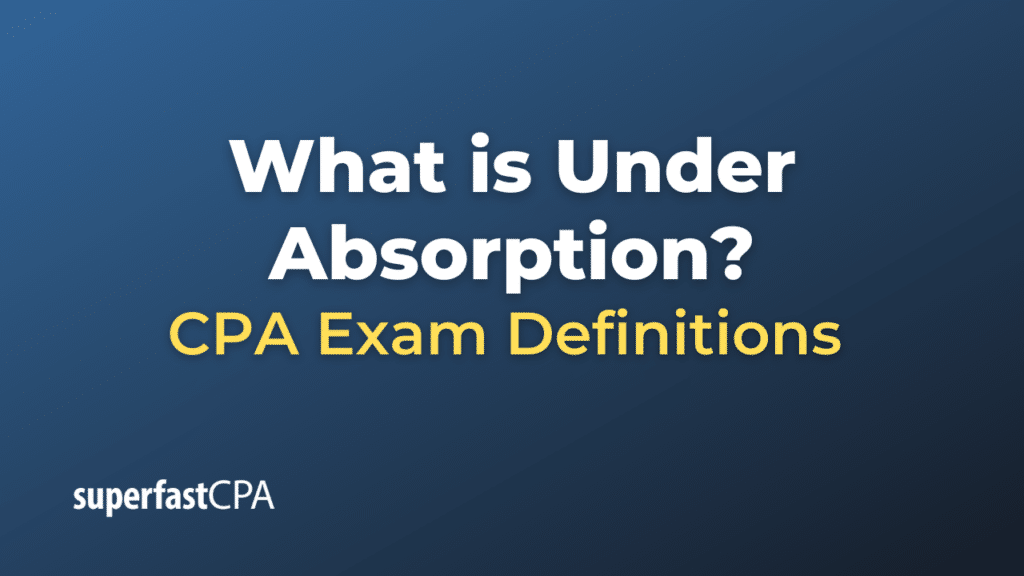Under Absorption
Under absorption, also known as underapplied overhead, refers to a situation in cost accounting where the actual manufacturing overhead costs are greater than the overhead costs that have been allocated or applied to goods produced during a specific accounting period. In simpler terms, under absorption occurs when the business incurs more overhead expenses than it anticipated based on its pre-set overhead rates.
How It Happens:
- Lower Production Levels: If the actual production levels are lower than anticipated, fixed overhead costs get spread over fewer units, leading to under absorption.
- Unexpected Overhead Costs: If unexpected expenses come up during the accounting period, this can also result in under absorption.
- Inaccurate Estimation: If the company underestimated the overhead rate initially, this could lead to under absorption.
Financial Implications:
- Increased Costs: Under absorption effectively means that the per-unit cost of goods manufactured would be underestimated, and thus the actual production cost is higher.
- Profit Impact: It can result in artificially inflated profits if not adjusted for, as the cost of goods sold would appear lower than it actually is.
- Inventory Valuation: Incorrect overhead allocation can also lead to incorrect inventory valuation, which in turn affects the balance sheet.
Accounting Adjustments:
Under absorption requires accounting adjustments. One common approach is to allocate the underabsorbed overhead back to cost of goods sold, work-in-progress, or finished goods inventory based on a rational allocation method.
Example of Under Absorption
Let’s delve into a simplified example to illustrate the concept of under absorption, using a fictional company called “WidgetCo.”
Scenario:
WidgetCo manufactures a single type of widget and had estimated the following for the upcoming year:
- Estimated annual overhead costs: $200,000
- Estimated annual production: 100,000 widgets
Based on these estimates, WidgetCo sets an overhead absorption rate of:
Overhead Absorption Rate = Estimated Overhead Costs / Estimated Production
= $200,000 / 100,000 widgets = $2 per widget
Actual Results:
At the end of the year, the actual results were:
- Actual overhead costs: $220,000
- Actual production: 95,000 widgets
Calculating Under Absorption:
- Calculate the overhead that was absorbed into the products during the year:
Absorbed Overhead = Actual Production x Overhead Absorption Rate
= 95,000 widgets x $2/widget = $190,000
- Calculate the amount of under-absorbed overhead:
Under-Absorbed Overhead = Actual Overhead Costs – Absorbed Overhead
= $220,000 – $190,000 = $30,000
So, WidgetCo has $30,000 of under-absorbed overhead, which means that the actual overhead costs were higher than what was allocated to the products.
Accounting Adjustments:
WidgetCo now has several options for dealing with this $30,000 of under-absorbed overhead:
- Allocate to Cost of Goods Sold (COGS): Increase the COGS by $30,000, which would reduce the gross margin and net profit.
- Allocate to Inventory: If some of the produced widgets are still in inventory, WidgetCo could allocate a portion of the $30,000 to the inventory value. This would affect the balance sheet.
- Allocate Across Both: Divide the $30,000 between COGS and inventory based on some rational basis (e.g., number of units, cost basis, etc.).
Implications:
- WidgetCo’s management needs to investigate why the overhead was under-absorbed. Was production less efficient than estimated? Were overhead costs underestimated?
- Future estimates may need to be adjusted to prevent this issue from recurring.
- Financial statements may be revised to accurately reflect costs and profits, ensuring they are not misleading.
Understanding and addressing under absorption is crucial for accurate financial reporting and effective managerial decision-making.













